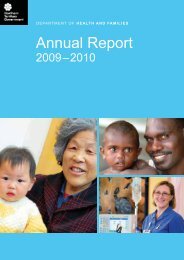PCD Strategy Evaluation 2007.pdf - NT Health Digital Library ...
PCD Strategy Evaluation 2007.pdf - NT Health Digital Library ...
PCD Strategy Evaluation 2007.pdf - NT Health Digital Library ...
You also want an ePaper? Increase the reach of your titles
YUMPU automatically turns print PDFs into web optimized ePapers that Google loves.
However the extraordinary number of recall systems in use across the <strong>NT</strong> is a major barrier tothe implementation of effective systematic chronic disease prevention and managementactivities. The recall systems are largely paper based in the remote clinics and these arereportedly cumbersome and therefore not used consistently by all staff. As of June 2007, therewas no regular or consistent reporting of chronic disease activities and outcomes, however this isexpected to change as the Aboriginal <strong>Health</strong> Key Performance Indicator reporting commences inJuly 2007.Assessment against the workforce objectives revealed that most services utilise a process forstaff orientation to ensure their workforce is prepared to deliver effective chronic diseaseprevention and management. A specific training module and programs were identified to supporttraining. While this is occurring the acute paradigm prevails in remote areas and there remainslittle time for preventative or health promotion work. Major barriers to participating in theseprograms were due to the mode of delivery and the lack of backfill to release staff to attendtraining. Systems to monitor attendance numbers, improve communication with the nongovernmentsector, and benchmarks in this area require improvement across all health sectors.Workforce development requires significant dedicated investment; and investigation into thepotential for interprofessional resourcing and activities is required.There was some evidence of a whole of government approach to improve educational outcomesand employment opportunities for the Indigenous population. The achievements of <strong>NT</strong>Indigenous and non-Indigenous students in achieving the 3 rd Grade National Literacy Benchmark,worsened with remoteness and Indigenousness between 2001-2005 (3) . Unemployment levelshave improved during this time, however it is unclear if this is due to real jobs or the CommunityDevelopment Employment Program (CDEP). The collection of Indigenous workforce data in the<strong>NT</strong> public sector workforce commenced in 2002 as part of an overall strategy. They report adoubling of the number of Indigenous employees in the <strong>NT</strong>DH&CS since that time, with only oneat an executive level. However these data are reportedly incomplete (4) . There is no reportedincrease in the number of Indigenous employees working in chronic disease. Concerningly, therehas been a reported significant decrease in the number of Aboriginal <strong>Health</strong> Worker positions andnumerous positions are vacant. The commencement in July 2007 of the Aboriginal <strong>Health</strong> WorkerApprenticeship Program and the Central Australian Divisions of Primary <strong>Health</strong> Care mental healthprogram is encouraging and both are expected to expand, recruiting 24 apprentices and 15<strong>Evaluation</strong> of the <strong>NT</strong> Preventable Chronic Disease <strong>Strategy</strong> 2007xi
















